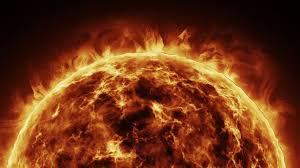Throughout our history, this majestic wonder has been a constant source of comfort, awe and worship but our understanding of the Sun has developed slowly. For centuries, the finest scientific minds sought to understand how it created a seemingly endless amount of heat and energy, s recently as the nneteenth century, science had little knowledge of what the sun was made of, where it had come from or the secret of its phenomenal power. It has existed for five billion years.
Every second. the Sun produces 400 million, million, million. million watts of power. That is a million times the power consumption of The USA every year, radiated in one second. No wonder that solar power is seen as a viable solution to the energy crisis.
As with every other star, the Sun was born from giant clouds of molecular dust and gas, it developed into a spinning ball if hot gas that is heated by a thermoneuclear reaction at its core. The Universe began 13.5 billion years ago in The Big Bang. In the first instant, it was incedibly hot and dense but it cooled very quickly. After only one second, it was cool enough for the UP and Down quarks to stick together into protons and neutrons.
The hydrogen neucleus is the simplest in nature. consisting of a single proton, Helium is the next simplest, built of two protons and one or two neutrons. Then comes lithium, beryllium, boron, carbon, nitrogen oxygen and so on, each with one more proton and accompanying neutrons. This process of sticking more and more protons and neutrons together to form the chemical elements is called neuclear fusion.
Protons carry a positive electric charge which means they are repelled when in close contact. if they can be forced close enough together. they can overcome this repellent force. Heat is the solution to this. For the first few moments in the life of the Universe, all of space was filled with was filled with particles that were hot enough to smash together and fuse. Around ten minutes after the Big Bang, the Universe had cooled down enough for fusion to cease, At that time the cosmos was 75% hydrogen and 25% hellium. with very small traces of lithium. Fusion did not reappear until the first stars were born, a few hundred million years later.
At the end of their life, stars run out of hydrogen fuel in their cores and more complex fusion reactions occur. Heavier elements are produced, oxygen, carbon, nitrogen, the elements of life. Every element in the Universe today was fused together from the primordial hydrogen and hellium left over from the Big Bang.
Eventually, as with all stars, the Sun's fuel will run out. This will start to reheat the Sun. Our Sun's brightness will increase by a factor of a thousand or more causing it to swell to many times its current size. The surface temperature will fall and its color will shift towards red. Mrecury will be engulfed, As it swells the Sun will strtch out towards Earth's orbit and our prospects are dim. The wonder that has been constant for 10 billion years will end its life as a giant red star. For a brief moment the Sun will be two thousand times as bright as it is now but eventually our star will shed its outer layers and all that will remain is a cooling core or White Dwarf that will glow until the end of time. The light that sustains all life here on Earth will be gone.
The gas and dust of the dying Sun will drift off into space and in time will form a vast. dark cloud primed and full of possibility. One day a new star will be born.

Helios
You began five billion years ago,your fusion heated protons, made them stick together, creating oxygencarbon, nitrogen, incubating life on Earth. You nurtured us with warmth and light, the ancients worshipped you. Now our fossil fuels are failingwe turn to youfor solar power and future nuclear fusion. We are back in the lunar raceto mine hellium 3perhaps there'll be a pipline or tankers to transport itthey say it's safer, cleaner,a better way to produce our energy. Thanks for reading. Adele Email ThisBlogThis!Share to TwitterShare to Facebook